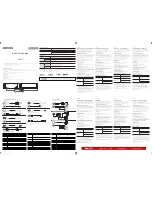
Oliver Stoners have one, two or three stone discharge traps depending on the model. The Oliver Model 2448
Stoner has one stone trap. The Model 3648 Stoner has two stone traps, and the Model 4848 Stoner and the
Model 6048 each have three stone traps.
The features of the deck will be discussed further in these instructions, but knowledge of their location is
important as well as understanding the controls that affect the four variable adjustments in the Oliver Stoner.
THE FOUR ADJUSTMENTS
All Stoners have four variable adjustments that must be properly adjusted and balanced to obtain optimum
separations. These are Feed Rate, Tilt, Eccentric Speed and Air Control. We will discuss the controls for each
of these variables in turn. (Please refer to Figure 6.)
FEED RATE
The feed rate control is located on the feeder and controls the amount fed onto the separating deck. Whether
you use standard Oliver feeders or supply your own feeder, you must have a means of controlling the feed.
The feed rate, whether fast or slow, should be uniform and free of surges. Surges in the incoming feed will
show up in the discharge of the machine as a poor quality separation. We suggest the use of surge bins
above the feeder, if processing will be interrupted.
Generally, the average feed rate is determined by the average capacity of the processing line of equipment.
For optimum separation on your stoner, your feed rate should be as low as possible without falling below the
minimum feed rate at which the deck can be fed and still obtain the necessary separation. When starting your
stoner, always start at the minimum feed rate; obtain your required separation, then increase the feed rate to
the desired capacity.
TILT
Tilt is the difference in the elevation between the high end of the deck and the low end of the deck. Increasing
tilt will cause the material to shift toward the low end of the deck. Decreasing tilt will cause the material to
shift toward the high end of the deck. Normally, the best separations are obtained when the tilt is set at or
near the maximum steepness. However, care should be taken not to set the tilt too steep. The tilt is too
steep when material cannot be made to flow toward the high end of the deck by increasing the eccentric
speed. Too little tilt is shown when all the material moves toward the heavy side of the deck despite a slow
eccentric speed. The tilt is adjusted by loosening the two clamping knobs (3) and moving the tilt adjustment
handle (2) in toward the machine for more tilt and away from the machine for less tilt.
ECCENTRIC SPEED
Eccentric speed and tilt are closely related. Increasing eccentric speed will cause material to be shifted
towards the high side of the deck. Decreasing eccentric speed will cause material to be shifted toward the low
side of the deck. Generally, by increasing eccentric speed (which shifts material toward the high side) and
increasing tilt (which shifts light material back toward the low side) a more precise separation can be
obtained. Too much eccentric speed can be observed when all the material shifts toward the high end of the
deck despite maximum tilt being used. Eccentric speed is adjusted by turning the "More Speed" control knob
(4) located on the side of the machine. Turning the knob counterclockwise increases the speed and turning
the knob clockwise decreases the speed.
-9-
Summary of Contents for Stoner
Page 24: ...return to index...
Page 25: ...return to index...











































